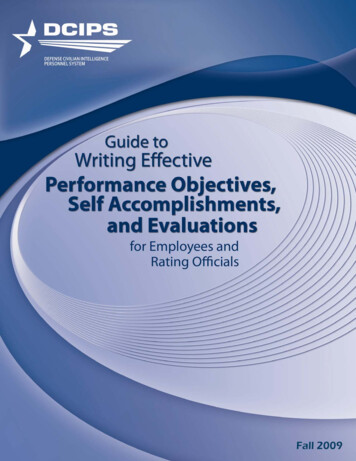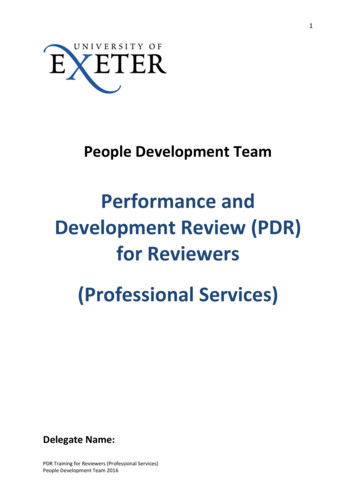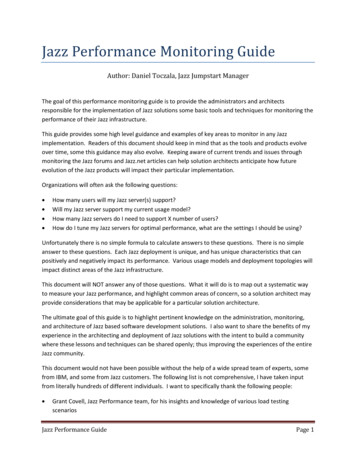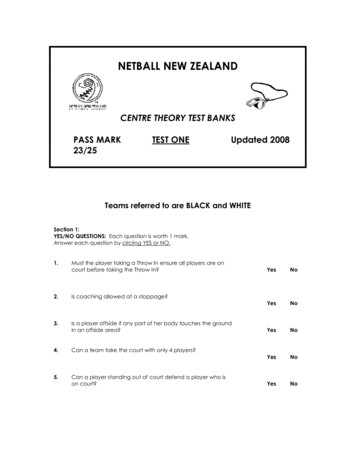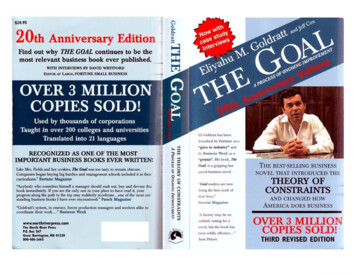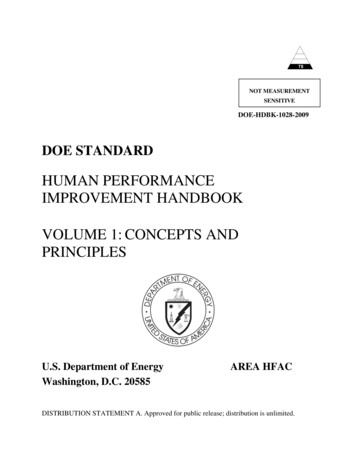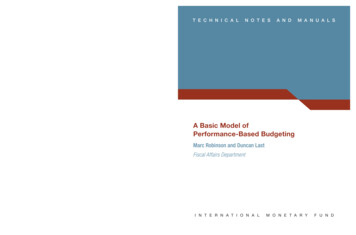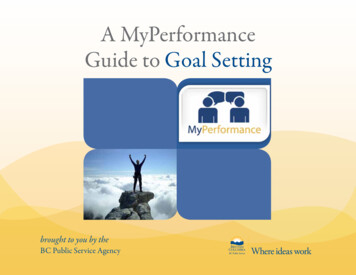
Transcription
A MyPerformanceGuide to Goal Settingbrought to you by theBC Public Service Agency
contentsOverview3What is Goal Setting?3Moving Beyond Procrastination4Current Research on Goal Setting4Goal Setting Frameworks5Key Principles for Goal Setting: S-M-A-R-T infused with H-A-R-D5Principle 1: Align Goals to Business Strategy6Principle 2: Make Goals Specifc and Animated6Principle 3: Make Goals Measurable and Heartfelt7Principle 4: Make Goals Attainable and Difcult8Principle 5: Make Goals Relevant and Required8Principle 6: Make Goals Time-bound8Principle 7: Track, Adjust and Acknowledge Progress toward Goals8Performance vs. Learning Goals9Sample Goal Statements9Closing Summary9
Overview“Goal setting is a powerful process. It’s based on the same principles of focus that allows us toconcentrate rays of difused sunlight into a force powerful enough to start a fre. It’s the practicalityof translating vision into achievable, actionable doing. It’s a common denominator of successfulindividuals and organizations.” Stephen Covey, First things FirstWe know from research and practical experience that efectivegoal setting can assist us in achieving greater results in both ourpersonal and professional life, and yet the process for great goalsetting is not often explored or discussed. This My PerformanceGuide to Goal Setting will provide employees and supervisorswith several principles, ideas and steps to create efective andmotivational goals that drive individual employee performanceand support organizational results. By setting goals that motivateyou, are truly worthwhile and are aligned to organizational goals,you will have a clearer map to your success. These importantlinkages are why MyPerformance places such importance onthe role of collaborative goal setting during your performanceconversations.Goal setting truly is the key to unlocking our full potential. TheMyPerformance approach creates the opportunity for trustedfeedback where you and your supervisor can explore and confrmhow your strengths and interests align with your work. Remember,MyPerformance is all about the conversation! It’s the conversation that infuses greater focus and meaning to the goal settingprocess; where we set goals that are bigger than just a task froma job description; where we link our goals to that of the team ororganization, receive trusted feedback on progress and learn fromchallenges that arise.A MyPerformance Guide to Goal SettingUltimately, the power of goal setting is that it serves to unlock fullpotential, which leads to higher performance and better businessresults if a few key principles are followed. Efective goal settingalso creates a more engaged workplace; people will come towork every day feeling engaged and create goals that help themto achieve great things, for their organization and themselves.So let’s take a fresh look at goal setting, share some wisdom andkey principles to remind ourselves about what really matters, andwhat motivates and helps us to enjoy the process of being ourbest as individuals and as an organization.What is Goal Setting?Goal setting, broadly speaking, is a process of working towardswho you want to be or what you want to do. This can be something complex such as exploring and developing the type ofleader you want to be, or something as simple as what you wantto do with your vacation and when you will take it. Once yourintention or goal is clear and compelling, it’s then a matter ofplanning towards it, tracking your progress and staying open tolearning and change along the way. Whether it’s done formallyor informally, goal setting is essential to focusing energy andresources, and to experience a sense of accomplishment andsatisfaction. Without it, there’s a feeling of being adrift withoutRESOURCE ALERTAre you looking for supportin goal setting?The BC Public Service Agencyofers the following resources: Planning for QualityPerformance Engagementin this workshop, you willbuild key work goals andperformance measures. Performance ManagementSnapshots - these are briefvideos ofering practicaltips, including efectivegoal setting.Visit The Learning Centreto fnd out about theseupcoming workshops.Page 3
direction or purpose, or of being disappointed as a result. Engagingin goal setting conversations is crucial for the supported directionof the individual and the organization.Moving Beyond ProcrastinationRESOURCE ALERTLooking for further researchand reading on SMART andHARD Goals? Please clickon these links for moreinformation:HARD Goals by Mark MurphyLeadershipIQ Study: AreSMART Goals Dumb? byLeadershipIQLocke’s Goal Setting Theory:Understanding SMART GoalSetting by Mind ToolsA MyPerformance Guide to Goal SettingAccording to collective experience, our track record or feelingsabout goal setting are mixed, and many of us struggle or hesitate insetting goals. For those of us who live by goal setting and stick toour goals no matter what, we can sometimes experience negativeimpacts on our health and relationships. For those of us whosee less value or staying power in goal setting, we may haveexperienced negative impacts on our sense of integrity andself-confdence when we don’t achieve our goals. Whateverviewpoint you see yourself in, you likely experienced thesechallenges with goal setting as a pattern throughout life. So whatkey piece may you be missing? It’s increased self-awareness thathelps you to overcome your challenges and create meaningfulgoals that become “the right thing, for the right reason, in theright way.” In other words, it’s not just about what, it’s also aboutwhy you have chosen a particular goal. It’s asking yourself, “is thisgoal aligned with my values and those of the organization?”It’s the why that makes a goal meaningful and gives you theenergy to continue when the going gets tough. Equallyimportant is knowing how you are going to achieve a particulargoal, which requires you to know and understand your preferences (view of the world), strengths, challenges, capacity and skilllevel. With this kind of knowledge and self awareness during goalsetting, it helps you to be more honest about what goals interestyou, more accurate in knowing what your current learning edgeis, and helps you identify barriers to success. In summary, whenapproaching goal setting with a high level of values alignmentand self awareness, you are more likely to succeed, be engagedand produce better results, and less likely to fall into commontraps, such as procrastination or avoidance.Current Research on Goal SettingAs organizations move towards supporting employees to unlocktheir full potential, more research is accumulating on what worksbest, particularly when it comes to goal setting for attaining higherperformance results. For example, in the most recent study byLeadershipIQ, 4,182 employees from 397 organizations weresurveyed about aspects of their organizations’ goal setting processand whether they achieved great things. The survey found thatonly 15 per cent of employees strongly agree that their goals willhelp them achieve great things, while only 13 per cent stronglyagree that their goals this year will help them maximize theirfull potential. Engagement levels were also found to becollated with goal setting. Overall, the analysis revealed the topeight predictors of whether employee goals would help themachieve great things and be engaging.Here are the top eight factors, in order of statistical importance:1. I can vividly picture how great it will feel when I achieve mygoals.2. I will have to learn new skills to achieve my assigned goals forthis year.3. My goals are absolutely necessary to help this company.4. I actively participated in creating my goals for this year.5. I have access to any formal training that I will need toaccomplish my goals.6. My goals for this year will push me out of my comfort zone.7. My goals will enrich the lives of somebody besides me(customers, the community, etc.).8. My goals are aligned with the organization’s top priorities forthis year.Page 4
Goal Setting FrameworksThe process of setting goals needs to be a transparent andcollaborative process between you and your supervisor. Whetherwriting long or short-term goals, the most widely-used frameworkhas been S-M-A-R-T goals.SpecifcMeasurableAttainable Well-defined to inform employees exactlywhat is expected, when, and how much.With specifc goals, managers can easilymeasure progress toward goal completion.performance in the goal setting process. In the MyPerformanceapproach to goal setting, S-M-A-R-T goals are infused withH-A-R-D goals to make your goals even ‘SMARTer’ and enhancethe level of focus, motivation and success you achieve throughgoal setting.Heartfelt My goal will enrich the lives of others (I careabout it and have an emotional attachmentto it).Provide milestones to track progress andmotivate employees toward achievement.Animated I can vividly picture/imagine how great itwill look/feel to achieve my goal.Success needs to be achievable with effortby an average employee, not too high ortoo low.Required My goal is absolutely necessary to help myorganization.Difcult I will have to learn new skills and leave mycomfort zone to achieve my goal.Relevant You should focus on the greatest impact tothe overall company strategy.Time-bound Establish enough time to achieve the goal,but not too much time to undermineperformance. Goals without deadlines tendto be overtaken by the day-to-day crises.Further to the S-M-A-R-T goal concept, Mark Murphy created analternative concept called H-A-R-D goals, which incorporatescurrent research in neuroscience. This adds to our understandingof what engages the brain, leading to greater success and higherKey Principles for Goal Setting: S-M-A-R-Tinfused with H-A-R-DThe MyPerformance approach to goal setting synthesizes keyprinciples, insights and wisdom to increase engagement andsuccess, as you create your goals and have performanceconversations with your supervisor, employees or colleagues.Ultimately, My Performance goal setting will help you unlock yourfull potential and achieve higher performance.“Learn from the past, set vivid, detailed goals for the future, and live in the only moment of timeover which you have any control: now.” DenIS WaItLeyA MyPerformance Guide to Goal SettingRESOURCE ALERTSample ConversationQuestions:Team/Group Conversation:What are the ministry,branch and team goals?How are they aligned? Whatis our team’s commonpurpose? What are mymanagers and supervisors’goals? What goals are ourteam working on and howare our individual goalsaligned with each other?How do we work together tocomplete those goals?One on One Conversation:What are my individualgoals? Which goals andtactics am I most interestedand responsible for implementing? How are my goalsaligned to my supervisor’sand colleague’s goals?Page 5
Goals AchievedEmployee, Branch andOrganizational SuccessGoal SettingConversationRESOURCE ALERTGuide for PerformanceConversationsSample ConversationQuestion:How does it look and feelto reach your goal?Principle 1: Align Goals to Business Strategy Principle 2: Make Goals Specifc andAnimatedGoal alignment is critical for an organization’s success and foremployee engagement. Most organizations see a dramaticincrease in employee and business performance, when theyefectively set individual employee goals and closely align themto the organization’s overall strategy and goals. Employees whoclearly understand how their goals relate to the larger goals of theorganization naturally become more engaged with their work.Successful organizations realize their achievements are linked totheir ability to manage, track and communicate goals. So toachieve goal alignment, individual goals need to stem from thebusiness plan and tactics. This also helps to prioritize goals tothose most urgent.It’s important for leaders and employees to share and discuss theirgoals and understand how their ministry, division, branch andteam goals align. These conversations need to happen at all levelsfor the business plan and tactics to succeed and have the bestresults throughout the organization. As a result, goals will be linkedboth vertically and horizontally so that all divisions, branches, teamsand individuals are in alignment with each other. With everyoneworking together toward the same objectives, the organizationcan execute strategy faster, with more fexibility and adaptability.Essentially, goal alignment strengthens leadership and createsorganizational agility.A MyPerformance Guide to Goal SettingIn order to make a goal specifc, it helps to make it animated, thatis, to visualize the goal and describe it vividly in concrete words.Since the human brain remembers pictures better than words,the biggest impediment to any goal can be lack of visual stimulation. It makes sense to make your goal visual by painting a pictureof it right down to the minute details, using mental images andconcrete words, which facilitate access to the right hemisphereof the brain (home of image and verbal systems). Also, by animatingyour goal in this way you will get the burst of motivation youneed to take your goal from vision to reality.When engaging in visualisation or the “mental rehearsal” ofachieving your goals, keep it simple. Start by engaging thatdaydreaming mechanism we all have. Visualize yourself being ordoing whatever your goal is, as if it has already happened. Thenlet this image play over and over again in your mind. This tricksyour subconscious to act as if it were real. That’s it!Even when writing your goals, it’s important to state them inthe positive (i.e., what you are aiming towards and not awayfrom). Also, using concrete words, rather than abstract words like“signifcant result”, makes them easier to visualize and remember.Page 6
“every goal worth doing is going to test your resolve and ask you to decide if you really wantto keep going. and at that moment, if your commitment to that goal is sufciently heartfelt,you’ll saddle up and plow right through.” Mark Murphy, hard GoalsTo be concrete, the signifcant result you are seeking must besomething you can experience or demonstrate. For example, itcould be creating a document that describes the elements ofthe workplace culture you are creating, or hosting an event witha particular theme, so employees could actually experience theorganizations brand or corporate values.There is no point in writing a goal that you will never remember,so keep it to one sentence! Anything extra is more your actionplan, detailing how you will achieve your goal.As a personal example, instead of saying, “I will meditate 10minutes every day," you would envision and describe how youwill feel physically and mentally when you have achieved thisroutine. Then write an outcome statement to reflect that, suchas, “By May, I will have improved my ability to focus andincreased awareness of my emotions." Use this approach withyour work goals, as well.Principle 3: Make Goals Measurable andHeartfeltIt’s important to develop what Mark Murphy terms a “heartfeltconnection” with a goal before adding any measurement to it.Others call this “having passion” in terms of our corporate values.This involves identifying with the goal at both the thinking andfeeling level, such as connecting it to your team’s business planand to the BC Public Service Values. Why? If you don’t really careabout your goal or fnd it meaningful, you’re not going to be asmotivated to achieve it. Current research on motivation showsthat tapping into our internal or intrinsic motivators leads togreater success in goal setting and higher performance. So themost powerful goals are those that are inherently satisfying ormeaningful, involving a heartfelt connection to what is importantto you or the organization.Adding measurement to a meaningful goal, helps you to see andacknowledge your progress. Being able to see the change occurin this way adds further focus and motivation. If you can create amental picture of what progress looks like before adding numbers to a goal, the motivational power of your goal increases stillfurther.For example, Apple created a goal around an innovative newproduct: “The IPod will be like having 1000 songs in your pocket.”This statement is brief, visual and has a measure to it. Anotherteam- based example could be, “With trusted feedback everyweek, my team will increase customer relationships and ourstakeholders will assist by joining our advisory group. We will havea full table by fscal year-end.”RESOURCE ALERTLooking for further researchor reading on motivation?Coaching Redefned:How Internal MotivationCan Fuel PerformanceDaniel Pink: The Puzzleof MotivationSample ConversationQuestions:Why do I care about thisgoal? Why is it important?How will I know when I ammaking progress towards mygoal? What will it look andfeel like?How could I make this goalclearer, more measurable?What will I be doingdiferently when I achievethis goal?Page 7A MyPerformance Guide to Goal Setting
Principle 4: Make Goals Attainable andDifcultRESOURCE ALERTSample ConversationQuestions:What are you afraid of that’sgetting in the way?What do you get out ofhaving this fear ordifculty?What is holding you back?What are you ready tochange? What are you notready to change yet?What are you learningfrom this goal?Is this goal a priority rightnow? For you? For theorganization?What could you do thatwould really make adiference (to your career/organization)?How much time do you need?A MyPerformance Guide to Goal SettingMake your goals both challenging and realistic. This involvesfnding the sweet spot of the goal, something attainable that alsohas a stretch to it. A strong goal is something that intrigues youwith the challenge, enough to hold your attention. We are talkingabout goals that call you to move out of your comfort zone, learnnew skills or try something diferent. For example, you may wantto work towards a team lead position or create a project that willmake improvements to workfow or client service. You’ll want toset a goal that stretches you as this will be more intrinsically motivating and engaging, so you are also more likely to see success.Principle 5: Make Goals Relevant andRequiredA goal needs to address something that is immediately needed,necessary and a priority. This helps to create the feeling ofurgency that we need to get us moving to action. We don’t setgoals for the sake of setting goals. Set goals that are necessary foryour performance, career and organizational success. A conversation with your supervisor is key here to ensure you are aligningyour goals with your organization’s current priorities.Principle 6: Make Goals Time-boundEstablish how much time you need to achieve your goal; berealistic so you maintain your performance and sense of urgencyto propel you to action. Goals without deadlines tend to beovertaken by the day-to-day crises. Check what the organization’stimelines are for larger goals or strategies and ensure that youwork within those, or if additional time is needed, there may be aplace for negotiating what is doable now and what may need towait.Principle 7: Track, Adjust andAcknowledge Progress toward GoalsIt’s important to track your progress on goals and be equippedwith what you need to review them with your supervisor, whocan then ofer support as necessary. Having documentation andspecifc examples handy is also helpful when your supervisoris not aware of all of the steps involved in reaching your goal.Tracking your goals in MyPerformance helps you stay on track inseveral ways: organize, manage and reassess your goals frequently. tweak goals where needed to keep them relevant andmeaningful. create action plans with milestones. track your time and make sure your daily efforts arefocused on meaningful tasks. provide information that you and your supervisor needwhen reviewing progress.It’s also important that you and your supervisor acknowledgeprogress towards your goals, no matter how small. This helps tokeep you positive, focused and motivated, especially when thegoal has a stretch and takes you into unchartered territory, whereself-doubt likes to live and side tracks us into fear, worry andprocrastination.“Feel the fear and do it anyway.” SUSAN JEFFERSPage 8
Performance vs. Learning GoalsIn MyPerformance Profle, there are tabs and sections for bothwork goals, and learning and development goals. If your workgoal requires learning something new, then there will be learninggoals linked to that work goal that will be recorded in the learningand development section. By linking your learning and development goals to your work goals in MyPerformance Profle, youcreate both organizational alignment and individual motivationtoward those goals. Remember, there are many diferent ways oflearning and developing; be sure to note anything you plan toachieve, from webinars to a Master’s thesis.Writing Goal Statements: What, Whyand HowAre you ready to get writing? An efective way to start bringing allthese principles together is to structure each goal into the What,Why, and how of the goal:WhatThe concise, opening statement for your goal.WhyDefnes why this goal is important to you andthe organization.HowThe plan or steps you will take to achieveyour goal.Goal Examples:My goal is to shift to a coaching leadership style (What), so that Ican bring out the best in my team (Why). I will do this by workingtowards certifcation in the BC Public Service SupervisoryDevelopment Program, and signing up for Performance Coaching(how).A MyPerformance Guide to Goal SettingMy goal is understand stakeholder needs (What), so that I caninfuence decision making on key issues (Why). I will do this bydesign, delivering a consultation process and writing a reportsummarising my fndings (how).My goal is to facilitate a culture shift towards excellence incommunication (What), so that all communication practices arebased on the principle of two-way symmetrical communication,engaging equal input from the public and the organization (Why).I will do this by creating a Culture Change Strategy, detailing alltactics (e.g. designing guidelines, processes, procedures) by theend of the second quarter.My goal is to create a lease agreement on crown land for aFirst Nations development project (What), which all parties arecomfortable signing, preserves the relationship and advances theeconomic objectives of the province and the local community(Why). I will do this by building trusting relationships with allparties, acquiring knowledge in industrial land use, mappingout the remaining tasks, assessing progress and creating thenegotiation document, all by April 2013.Closing SummaryThis MyPerformance Guide to Goal Setting was designed tosupport employees and supervisors with MyPerformanceconversations and the process of collaborative goal setting.The information provided is a reminder of key principles andpractices that make the goal setting process more efective.By following the principles of S-M-A-R-T infused with H-A-R-D,the outcome will be cascading goals, aligned from the top tobottom of the organization. They will be both motivating andmeaningful, and the key to success and high performance foremployees and the organization. Ultimately, the use of theseprinciples will bring greater focus and meaning toMyPerformance conversations. Remember, MyPerformance:it’s all about the conversations.RESOURCE ALERTAre you looking for support inrecording your conversationsinto your and/or employee’sMyPerformance Profle?Click on the Profle Help buttonProfle Helpin your MyPerformanceProfle where you will fndhelpful toolslike proflesamples, user guide, and FAQ’s.To get started, visit MyHRfor a direct link to yourMyPerformance Profle.Page 9
Whether approach to goal setting, S-M-A-R-T goals are infused with writing long or short-term goals, the most widely-used framework H-A-R-D goals to make your goals even ‘SMARTer’ and enhance . has been S-M-A-R-T

